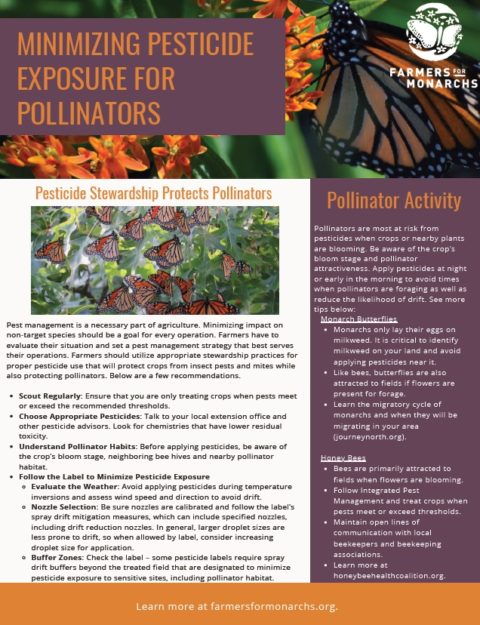PESTICIDE STEWARDSHIP PROTECTS POLLINATORS
Pest management is a necessary part of agriculture. Minimizing impact on non-target species should be a goal for every operation. Farmers have to evaluate their situation and set a pest management strategy that best serves their operations. Farmers should utilize appropriate stewardship practices for proper pesticide use that will protect crops from insect pests and mites while also protecting pollinators. Below are a few recommendations.
-
Scout Regularly: Ensure that you are only treating crops when pests meet or exceed the recommended thresholds.
-
Choose Appropriate Pesticides: Talk to your local extension office and other pesticide advisors. Look for chemistries that have lower residual toxicity.
-
Understand Pollinator Habits: Before applying pesticides, be aware of the crop’s bloom stage, any potential neighboring bee hives and nearby pollinator habitat.
-
Follow the Label to Minimize Pesticide Exposure:
-
Evaluate the Weather: Avoid applying pesticides during temperature inversions and assess wind speed and direction to avoid drift.
-
Nozzle Selection: Be sure nozzles are calibrated and follow the label’s spray drift mitigation measures, which can include specified nozzles, including drift reduction nozzles. In general, larger droplet sizes are less prone to drift, so when allowed by label, consider increasing droplet size for application.
-
Buffer Zones: Check the label – some pesticide labels require spray drift buffers beyond the treated field that are designated to minimize pesticide exposure to sensitive sites, including pollinator habitat.
-

POLLINATOR ACTIVITY
Pollinators are most at risk from pesticides when crops or nearby plants are blooming. See tips below.
-
Apply pesticides at night or early in the morning to avoid times when pollinators are foraging as well as reduce the likelihood of drift.
-
Monarchs only lay their eggs on milkweed. It is critical to identify milkweed on your land and avoid applying pesticides near it.
-
Like bees, butterflies are also attracted to fields if flowers are present for forage. Also be aware of a crop’s bloom stage and pollinator attractiveness.
-
Learn the migratory cycle of monarchs and when they will be migrating in your area by visiting journeynorth.org.
-
Bees are primarily attracted to fields when flowers are blooming.
-
Follow Integrated Pest Management and treat crops when pests meet or exceed thresholds.
-
Maintain open lines of communication with local beekeepers and beekeeping associations.
-
Learn more at about bee health from the Honey Bee Health Coalition.

